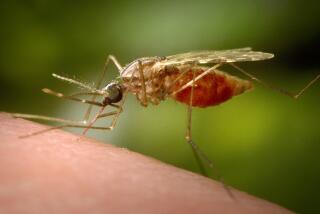Malaria May Show Signs Months Later
- Share via
Four months after her return from a trip to India, a Chicago woman went to the Cook County (Ill.) Hospital emergency department complaining of persistent, strong headaches. The headaches occurred every other day, then disappeared for two weeks before the pattern resumed.
The diagnosis? Malaria, caused by Plasmodium vivax, an infectious organism transmitted by the bite of a mosquito.
Dr. Kamaljit Singh, a fellow in infectious diseases at Rush Medical College and Cook County Hospital, relays the case history to illustrate how elusive a diagnosis of malaria can be in travelers returning from malaria-endemic areas.
One in five people with malaria who visited Cook County Hospital from 1991 to 1999 was misdiagnosed, Singh told colleagues at the recent annual meeting of the Infectious Diseases Society of America.
The situation is not unusual, he says. Studies in medical literature estimate that 20% to 80% of patients with malaria are initially misdiagnosed.
The findings at his hospital, Singh says, point to a need for travelers returning from malaria-endemic areas to be vigilant about symptoms and to seek medical help, even if the symptoms appear months after their return home.
It’s not surprising that malaria often is overlooked, Singh says, because “the signs and symptoms are extremely vague.” But the test for malaria is simple: A physician takes a few drops of blood and studies them under a microscope for parasites carrying malaria in the blood cells. If the smear is negative but symptoms persist, the test should be repeated, Singh says.
Fever of 100.4 degrees or above is the typical symptom, Singh says. But there can also be flu-like symptoms, such as chills, headache and malaise, according to the Centers for Disease Control and Prevention, and the symptoms can occur in cycles.
Left untreated, malaria can cause kidney failure, coma, even death. But malarial infection is preventable.
Besides keeping one’s arms and legs covered, avoiding mosquito infestations and using repellents, travelers to malaria-prone areas are advised to take antimalarial drugs in advance as a precaution. They can also take along pyrimethamine-sulfadoxine (Fansidar) to treat themselves temporarily if they suspect they’ve contracted malaria and professional medical care is not available within 24 hours.
Most of the subjects in Singh’s Chicago study had emigrated from Africa, India or Central America, where malaria is prevalent. They either were recent immigrants or had returned to this country after visiting family back home. Many thought they were immune because of previous exposure, and only one took antimalarial medicine, which includes mefloquine (Lariam), chloroquine (Aralen), doxycycline and the new Malarone (atovaquone and proguanil). The Food and Drug Administration said the Malarone formula has proved effective in regions where resistance to other antimalaria drugs has developed.
“Just because you have lived in a malarious area and are now in the U.S. does not mean you can go back and not have problems,” Singh says. “Immunity wanes away with time.”
It can take weeks or months for malaria symptoms to appear. The patients in Singh’s study who had P. falciparum malaria reported the onset of symptoms almost 11 days after leaving the malarial area. Those with P. vivax malaria noticed symptoms 55 days after exposure, on average.
The Cook County findings don’t surprise Dr. David Dassey, deputy chief of the Acute Communicable Disease Control Unit for the Los Angeles County Department of Health Services. “Malaria is very well known as a great mimicker,” he says. It might be misdiagnosed, for instance, as a viral respiratory or gastrointestinal illness.
In Los Angeles County, 63 cases of malaria were diagnosed in 1999 and 50 in 1998, Dassey says. More than half the patients were U.S. residents who contracted malaria during foreign travel; the others were recent immigrants or visitors.
According to the CDC, malaria transmission occurs in large parts of Central and South America, Hispaniola, sub-Saharan Africa, the Indian subcontinent, Southeast Asia, the Middle East and Oceania.
Kathleen Doheny can be reached at kdoheny@compuserve.com.
More to Read
Sign up for Essential California
The most important California stories and recommendations in your inbox every morning.
You may occasionally receive promotional content from the Los Angeles Times.












